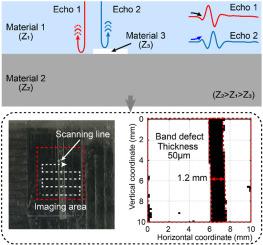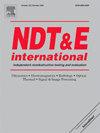基于宽带PMUT阵列的多层复合结构界面分层检测
IF 4.5
2区 材料科学
Q1 MATERIALS SCIENCE, CHARACTERIZATION & TESTING
引用次数: 0
摘要
与传统的超声探头相比,压电微机械超声换能器(PMUT)阵列具有体积小、一致性好、灵敏度高等优点,在复合材料探伤领域具有诸多优势。但在实际检测过程中,轴向分辨率低、回波重叠等问题严重阻碍了PMUT复合材料探伤装置的进一步发展。本文采用多尺寸混频结构设计了一种中心频率为2 MHz的宽带(75%)PMUT。同时,基于声学相位翻转现象,提出了一种平移窗口信号的相关系数法,通过计算回波前的相位差,可以准确识别出微小(50 μm厚,1/10波长)的分层缺陷,成功突破了半波长检测极限。此外,两类脱层缺陷的c扫描成像结果也验证了PMUT器件及检测算法在复合材料脱层缺陷检测中的能力。上述研究为超声器件在固体微尺寸缺陷检测领域的进一步发展提供了研究思路。本文章由计算机程序翻译,如有差异,请以英文原文为准。

Interfacial delamination detection of multilayer composite structures based on broadband PMUT arrays
Compared to traditional ultrasonic probes, piezoelectric micromechanical ultrasound transducer (PMUT) arrays have many advantages in the field of composite flaw detection owing to their small size, good consistency, and high sensitivity. However, in the actual detection process, the problems of low axial resolution and echo overlap significantly hinder the further development of PMUT devices for composite flaw detection. In this study, a broadband (75 %) PMUT with a center frequency of 2 MHz was designed using a multi-size mixing structure. At the same time, based on the acoustic phase flip phenomenon, a correlation coefficient method of translational window signals is proposed, which can accurately identify tiny (50-μm-thick, 1/10 wavelength) delamination defects by calculating the phase difference of the echo front, and successfully breaks through the half-wavelength detection limit. In addition, the C-scan imaging results of the two types of delamination defects demonstrate the capability of the PMUT device and detection algorithm in the detection of delamination defects in composite materials. This above study provides research ideas for the further development of ultrasonic devices in the field of solid micro-sized defect detection.
求助全文
通过发布文献求助,成功后即可免费获取论文全文。
去求助
来源期刊

Ndt & E International
工程技术-材料科学:表征与测试
CiteScore
7.20
自引率
9.50%
发文量
121
审稿时长
55 days
期刊介绍:
NDT&E international publishes peer-reviewed results of original research and development in all categories of the fields of nondestructive testing and evaluation including ultrasonics, electromagnetics, radiography, optical and thermal methods. In addition to traditional NDE topics, the emerging technology area of inspection of civil structures and materials is also emphasized. The journal publishes original papers on research and development of new inspection techniques and methods, as well as on novel and innovative applications of established methods. Papers on NDE sensors and their applications both for inspection and process control, as well as papers describing novel NDE systems for structural health monitoring and their performance in industrial settings are also considered. Other regular features include international news, new equipment and a calendar of forthcoming worldwide meetings. This journal is listed in Current Contents.
 求助内容:
求助内容: 应助结果提醒方式:
应助结果提醒方式:


